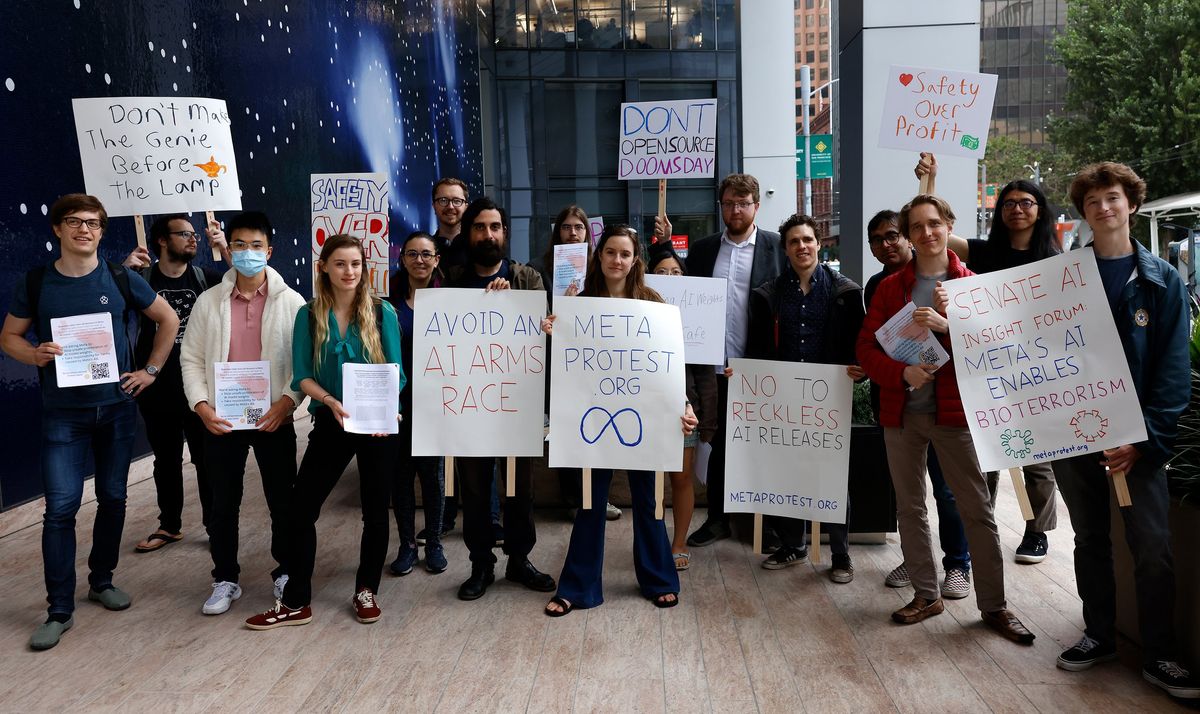But others say open source is the only way to make AI trustworthy

spectrum.ieee.org
NEWS
Protesters Decry Meta’s “Irreversible Proliferation” of AI
But others say open source is the only way to make AI trustworthy
EDD GENT
06 OCT 2023
4 MIN READ
Protesters likened Meta's public release of its large language models to weapons of mass destruction.
MISHA GUREVICH
ARTIFICIAL INTELLIGENCEOPEN SOURCEMETAAI SAFETYLARGE LANGUAGE MODELS
Efforts to make AI open source have become a lightning rod for disagreements about the potential harms of the emerging technology. Last week, protesters gathered outside Meta’s San Francisco offices to protest its policy of publicly releasing its AI models, claiming that the releases represent “irreversible proliferation” of potentially unsafe technology. But others say that an open approach to AI development is the only way to ensure trust in the technology.
While companies like
OpenAI and
Google only allow users to access their
large language models (LLMs) via an API,
Meta caused a stir last February when it made its
LLaMA family of models freely accessible to AI researchers. The release included model weights—the parameters the models have learned during training—which make it possible for anyone with the right hardware and expertise to reproduce and modify the models themselves.
Within weeks the weights were leaked online, and the company was criticized for potentially putting powerful AI models in the hands of nefarious actors, such as hackers and scammers. But since then, the company has doubled down on
open-source AI by releasing the weights of its next-generation
Llama 2 models without any restrictions.
The self-described “concerned citizens” who gathered outside Meta’s offices last Friday were led by
Holly Elmore. She notes that an API can be shut down if a model turns out to be unsafe, but once model weights have been released, the company no longer has any means to control how the AI is used.
“It would be great to have a better way to make a [large language] model safe other than secrecy, but we just don’t have it.” —Holly Elmore, AI safety advocate
“Releasing weights is a dangerous policy, because models can be modified by anyone, and they cannot be recalled,” says Elmore, an independently funded AI safety advocate who previously worked for the think tank
Rethink Priorities. “The more powerful the models get, the more dangerous this policy is going to get.” Meta didn’t respond to a request for comment.
MISHA GUREVICH
LLMs accessed through an API typically feature various safety features, such as response filtering or specific training to prevent them from providing dangerous or unsavory responses. If model weights are released, though, says Elmore, it’s relatively easy to retrain the models to bypass these guardrails. That could make it possible to use the models to craft phishing emails, plan cyberattacks, or cook up ingredients for dangerous chemicals, she adds.
Part of the problem is that there has been insufficient development of “safety measures to warrant open release,” Elmore says. “It would be great to have a better way to make a model safe other than secrecy, but we just don’t have it.”
Beyond any concerns about how today’s open-source models could be misused, Elmore says, the bigger danger will come if the same approach is taken with future, more powerful AI that could act more autonomously.
That’s a concern shared by
Peter S. Park, AI Existential Safety Postdoctoral Fellow at MIT. “Widely releasing the very advanced AI models of the future would be especially problematic, because preventing their misuse would be essentially impossible,” he says, adding that they could “enable rogue actors and nation-state adversaries to wage cyberattacks, election meddling, and bioterrorism with unprecedented ease.”
So far, though, there’s little evidence that open-source models have led to any concrete harm, says
Stella Biderman, a scientist at Booz Allen Hamilton and executive director of the nonprofit AI research group
EleutherAI, which also makes its models open source. And it’s far from clear that simply putting a model behind an API solves the safety problem, she adds, pointing to a
recent report from the European Union’s law-enforcement agency, Europol, that
ChatGPT was being used to generate malware and that safety features were “trivial to bypass.”
Encouraging companies to keep the details of their models secret is likely to lead to “serious downstream consequences for transparency, public awareness, and science.”—Stella Biderman, EleutherAI
The reference to “proliferation,” which is clearly meant to evoke weapons of mass destruction, is misleading, Biderman adds. While the secrets to building nuclear weapons are jealously guarded, the fundamental ingredients for building an LLM have been published in freely available research papers. “Anyone in the world can read them and develop their own models,” she says.
The argument against releasing model weights relies on the assumption that there will be no malicious corporate actors, says Biderman, which history suggests is misplaced. Encouraging companies to keep the details of their models secret is likely to lead to “serious downstream consequences for transparency, public awareness, and science,” she adds, and will mainly impact independent researchers and hobbyists.
But it’s unclear if Meta’s approach is really open enough to derive the benefits of open source. Open-source software is considered trustworthy and safe because people are able to understand and probe it, says Park. That’s not the case with Meta’s models, because the company has provided few details about its training data or training code.
The concept of open-source AI has yet to be properly defined, says
Stefano Maffulli, executive director of the Open Source Initiative (OSI). Different organizations are using the term to refer to different things. “It’s very confusing, because everyone is using it to mean different shades of ‘publicly available something,’ ” he says.
For a piece of software to be open source, says Maffulli, the key question is whether the source code is publicly available and reusable for any purpose. When it comes to making AI freely reproducible, though, you may have to share training data, how you collected that data, training software, model weights, inference code, or all of the above. That raises a host of new challenges, says Maffulli, not least of which are privacy and copyright concerns around the training data.
OSI has been working since last year to define what exactly counts as open-source AI, says Maffulli, and the organization is planning to release an early draft in the coming weeks. But regardless of how the concept of open source has to be adapted to fit the realities of AI, he believes an open approach to its development will be crucial. “We cannot have AI that can be trustworthy, that can be responsible and accountable if it’s not also open source,” he says.

















